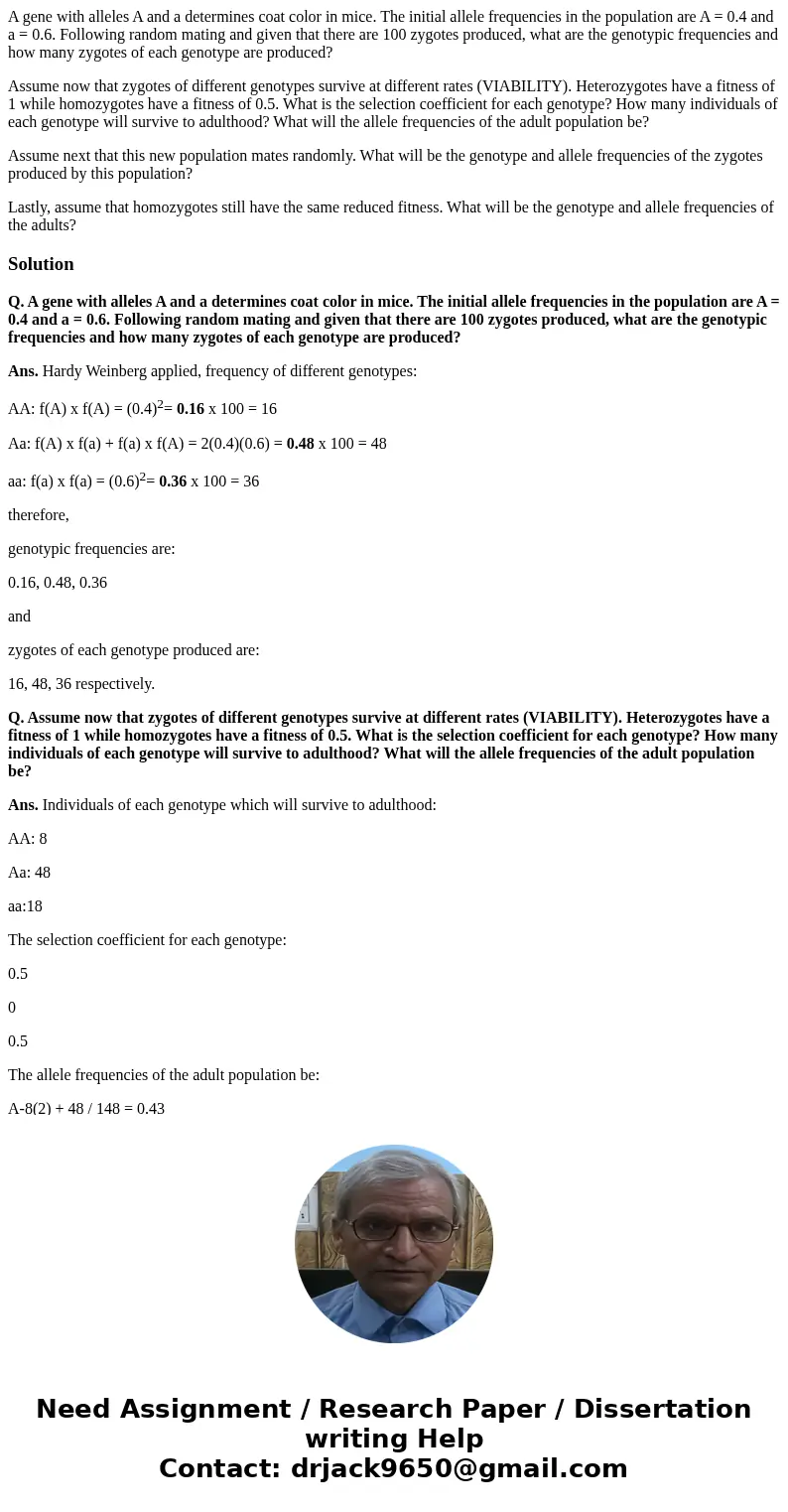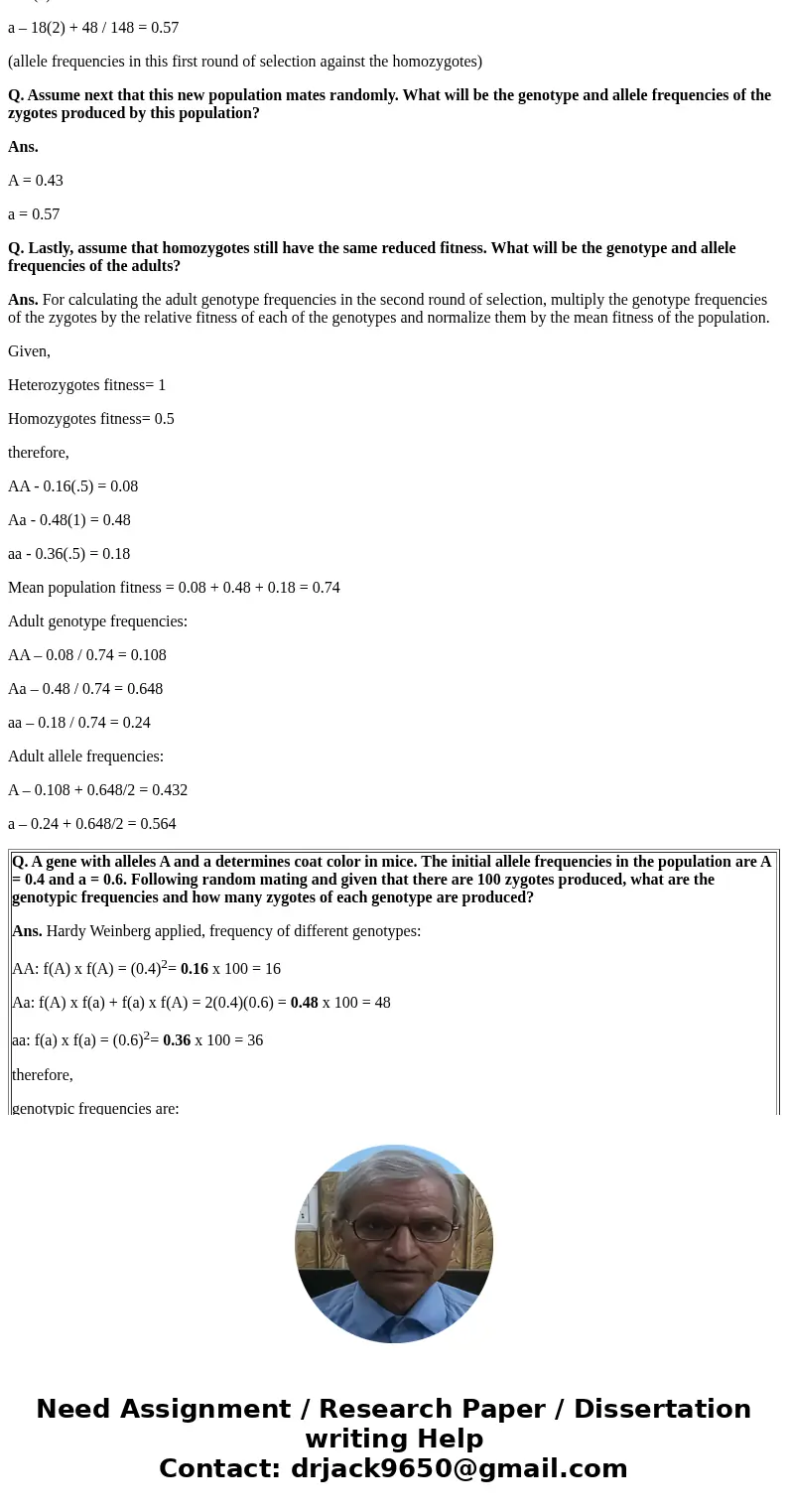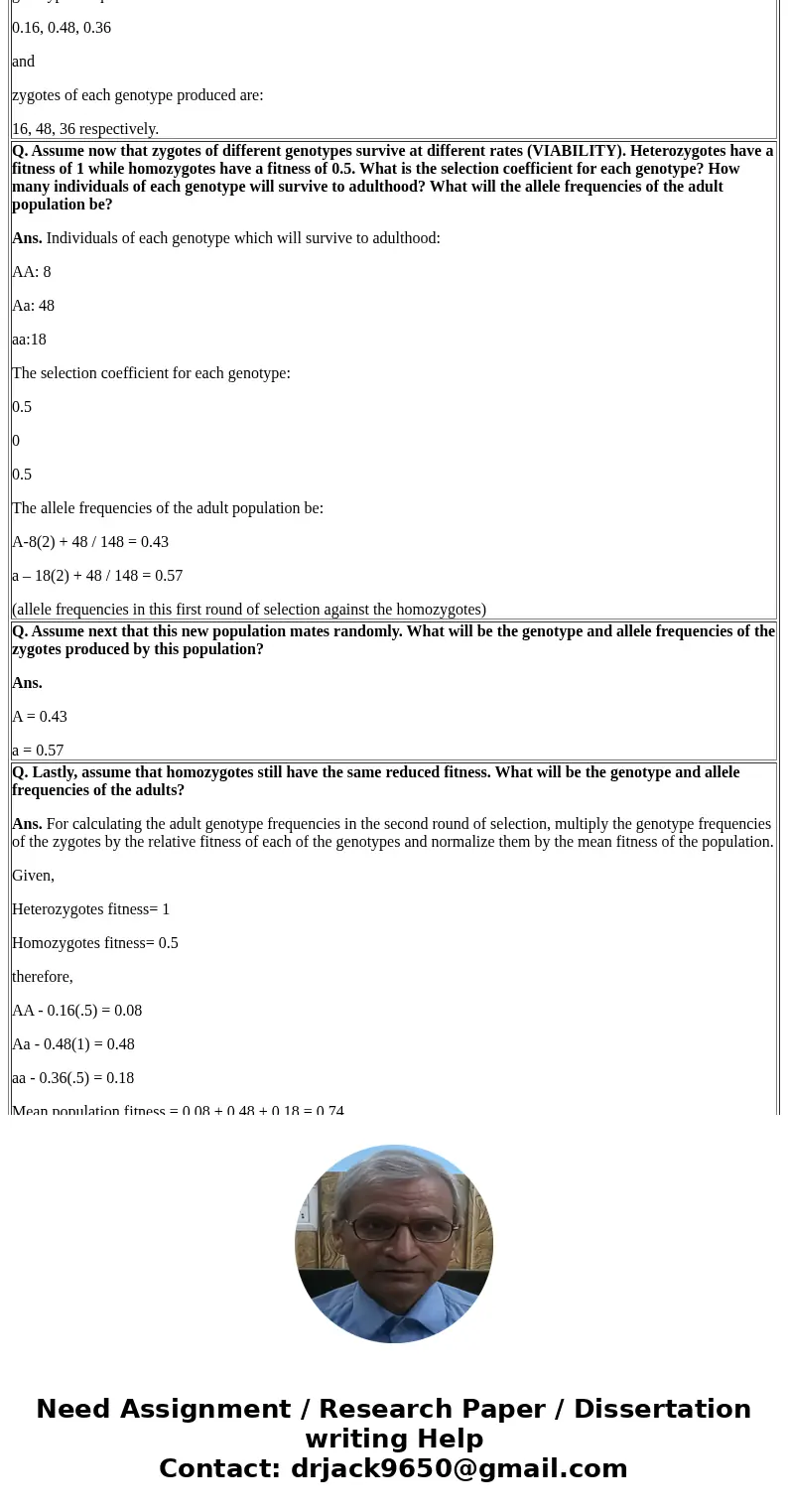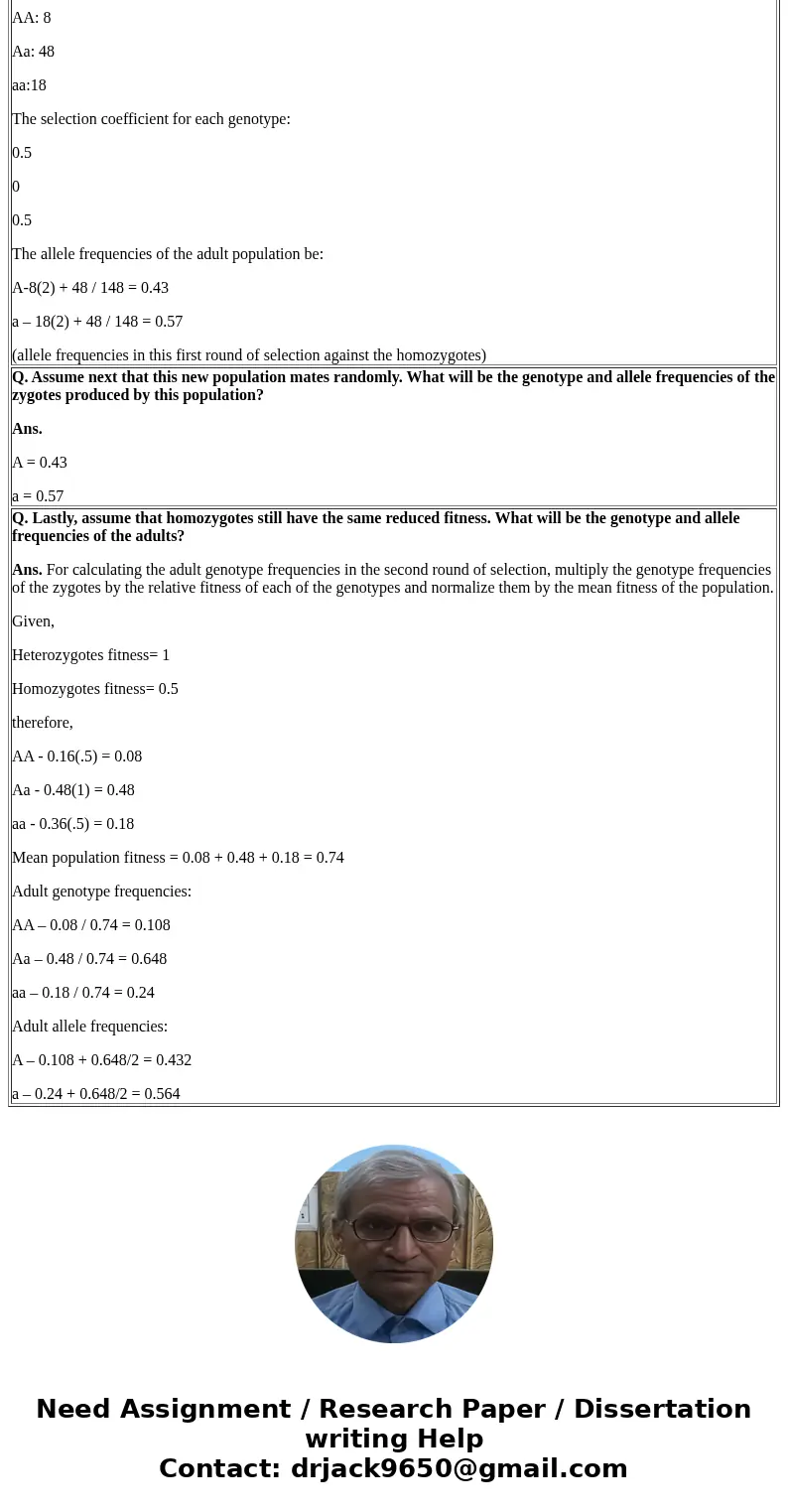A gene with alleles A and a determines coat color in mice Th
A gene with alleles A and a determines coat color in mice. The initial allele frequencies in the population are A = 0.4 and a = 0.6. Following random mating and given that there are 100 zygotes produced, what are the genotypic frequencies and how many zygotes of each genotype are produced?
Assume now that zygotes of different genotypes survive at different rates (VIABILITY). Heterozygotes have a fitness of 1 while homozygotes have a fitness of 0.5. What is the selection coefficient for each genotype? How many individuals of each genotype will survive to adulthood? What will the allele frequencies of the adult population be?
Assume next that this new population mates randomly. What will be the genotype and allele frequencies of the zygotes produced by this population?
Lastly, assume that homozygotes still have the same reduced fitness. What will be the genotype and allele frequencies of the adults?
Solution
Q. A gene with alleles A and a determines coat color in mice. The initial allele frequencies in the population are A = 0.4 and a = 0.6. Following random mating and given that there are 100 zygotes produced, what are the genotypic frequencies and how many zygotes of each genotype are produced?
Ans. Hardy Weinberg applied, frequency of different genotypes:
AA: f(A) x f(A) = (0.4)2= 0.16 x 100 = 16
Aa: f(A) x f(a) + f(a) x f(A) = 2(0.4)(0.6) = 0.48 x 100 = 48
aa: f(a) x f(a) = (0.6)2= 0.36 x 100 = 36
therefore,
genotypic frequencies are:
0.16, 0.48, 0.36
and
zygotes of each genotype produced are:
16, 48, 36 respectively.
Q. Assume now that zygotes of different genotypes survive at different rates (VIABILITY). Heterozygotes have a fitness of 1 while homozygotes have a fitness of 0.5. What is the selection coefficient for each genotype? How many individuals of each genotype will survive to adulthood? What will the allele frequencies of the adult population be?
Ans. Individuals of each genotype which will survive to adulthood:
AA: 8
Aa: 48
aa:18
The selection coefficient for each genotype:
0.5
0
0.5
The allele frequencies of the adult population be:
A-8(2) + 48 / 148 = 0.43
a – 18(2) + 48 / 148 = 0.57
(allele frequencies in this first round of selection against the homozygotes)
Q. Assume next that this new population mates randomly. What will be the genotype and allele frequencies of the zygotes produced by this population?
Ans.
A = 0.43
a = 0.57
Q. Lastly, assume that homozygotes still have the same reduced fitness. What will be the genotype and allele frequencies of the adults?
Ans. For calculating the adult genotype frequencies in the second round of selection, multiply the genotype frequencies of the zygotes by the relative fitness of each of the genotypes and normalize them by the mean fitness of the population.
Given,
Heterozygotes fitness= 1
Homozygotes fitness= 0.5
therefore,
AA - 0.16(.5) = 0.08
Aa - 0.48(1) = 0.48
aa - 0.36(.5) = 0.18
Mean population fitness = 0.08 + 0.48 + 0.18 = 0.74
Adult genotype frequencies:
AA – 0.08 / 0.74 = 0.108
Aa – 0.48 / 0.74 = 0.648
aa – 0.18 / 0.74 = 0.24
Adult allele frequencies:
A – 0.108 + 0.648/2 = 0.432
a – 0.24 + 0.648/2 = 0.564
| Q. A gene with alleles A and a determines coat color in mice. The initial allele frequencies in the population are A = 0.4 and a = 0.6. Following random mating and given that there are 100 zygotes produced, what are the genotypic frequencies and how many zygotes of each genotype are produced? Ans. Hardy Weinberg applied, frequency of different genotypes: AA: f(A) x f(A) = (0.4)2= 0.16 x 100 = 16 Aa: f(A) x f(a) + f(a) x f(A) = 2(0.4)(0.6) = 0.48 x 100 = 48 aa: f(a) x f(a) = (0.6)2= 0.36 x 100 = 36 therefore, genotypic frequencies are: 0.16, 0.48, 0.36 and zygotes of each genotype produced are: 16, 48, 36 respectively. |
| Q. Assume now that zygotes of different genotypes survive at different rates (VIABILITY). Heterozygotes have a fitness of 1 while homozygotes have a fitness of 0.5. What is the selection coefficient for each genotype? How many individuals of each genotype will survive to adulthood? What will the allele frequencies of the adult population be? Ans. Individuals of each genotype which will survive to adulthood: AA: 8 Aa: 48 aa:18 The selection coefficient for each genotype: 0.5 0 0.5 The allele frequencies of the adult population be: A-8(2) + 48 / 148 = 0.43 a – 18(2) + 48 / 148 = 0.57 (allele frequencies in this first round of selection against the homozygotes) |
| Q. Assume next that this new population mates randomly. What will be the genotype and allele frequencies of the zygotes produced by this population? Ans. A = 0.43 a = 0.57 |
| Q. Lastly, assume that homozygotes still have the same reduced fitness. What will be the genotype and allele frequencies of the adults? Ans. For calculating the adult genotype frequencies in the second round of selection, multiply the genotype frequencies of the zygotes by the relative fitness of each of the genotypes and normalize them by the mean fitness of the population. Given, Heterozygotes fitness= 1 Homozygotes fitness= 0.5 therefore, AA - 0.16(.5) = 0.08 Aa - 0.48(1) = 0.48 aa - 0.36(.5) = 0.18 Mean population fitness = 0.08 + 0.48 + 0.18 = 0.74 Adult genotype frequencies: AA – 0.08 / 0.74 = 0.108 Aa – 0.48 / 0.74 = 0.648 aa – 0.18 / 0.74 = 0.24 Adult allele frequencies: A – 0.108 + 0.648/2 = 0.432 a – 0.24 + 0.648/2 = 0.564 |




 Homework Sourse
Homework Sourse